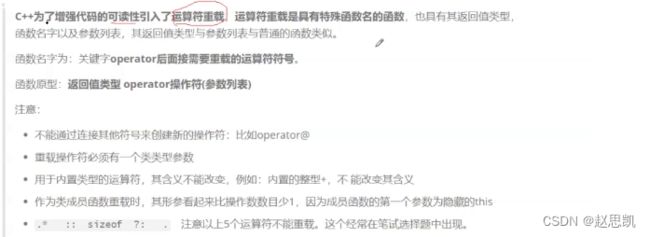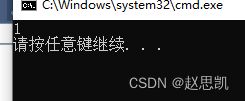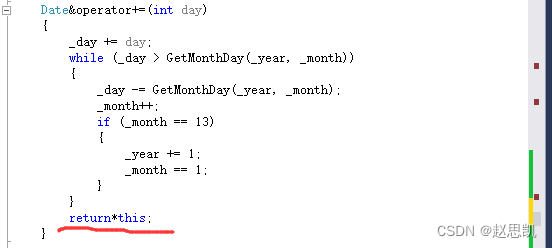日期类的实现
目录
运算符重载:
日期类:
日期的>
日期类+天数:
+=的实现:
+天数函数:
class Stack
{
public:
Stack(int capacity=4 )
{
_a = (int*)malloc(sizeof(int)*capacity);
if (_a == nullptr)
{
perror("malloc fail");
exit(-1);
}
_top = 0;
_capacity = capacity;
cout << "Stack构造函数()" << endl;
}
Stack(const Stack&st)
{
_a=(int*)malloc(sizeof(int)*st._capacity);
if (_a == nullptr)
{
perror("malloc fail");
exit(-1);
}
memcpy(_a, st._a, sizeof(int)*st._top);
_top = st._top;
_capacity = st._capacity;
}
void Push(int x)
{
_a[_top++] = x;
}
~Stack()
{
free(_a);
_a = nullptr;
_top = _capacity = 0;
cout << "Stack析构函数()" << endl;
}
private:
int*_a;
int _capacity;
int _top;
};
class MyQueue
{
public:
void push(int x)
{
}
private:
Stack _pushSt;
Stack _popSt;
size_t size ;
};
int main()
{
MyQueue m1;
MyQueue q(m1);
return 0;
}MyQueue这个类需要自定义拷贝构造函数吗?
答:不需要,对于内置类完成值拷贝,对于自定义类型调用其默认拷贝构造。
Stack有默认的拷贝构造。
完成了深拷贝。
运算符重载:
运算符重载使类函数调用可读更强。
日期类:
我们先写一个日期类比较大小。
我们要想实现符号重载,需要自主实现一个>函数。
我们可以先实现一个简单的判断相等函数:
bool operator==(const Date&d1, const Date&d2)
{
return d1._year == d2.__year
&&d1._month == d2._month
&&d1._day == d2._day;
}但是我们的函数写在类外面,无法访问类里面的成员变量,我们的方法是把函数定义在类里面:
但是注意:==函数有两个操作数,所以只有两个参数:
类成员函数都有一个默认参数:隐含的 this指针,所以:
bool operator==(const Date&d1)
{
return _year == d1._year
&&_month == d1._month
&&_day == d1._day;
}<<优先级要大于==,所以我们要加上()。
假如我们必须在类外面进行运算符重载呢?
我们无法提取到成员变量,我们可以设计一个成员函数,提取到对应对象的成员变量:
int GetYear()
{
return _year;
}
int GetMonth()
{
return _month;
}
int GetDay()
{
return _day;
}日期的>
bool operator>(const Date&d1)
{
if (_year > d1._year)
{
return true;
}
else if (_year ==d1._year&&_month >d1._month)
{
return true;
}
else if (_year == d1._year&&_month == d1._month&&_day >d1._day)
{
return true;
}
else
return false;
}int main()
{
Date d1(2022, 9, 22);
Date d2(2022, 9, 21);
/*d1.operator==(d2);*/
cout << (d1>d2) << endl;
}有了大于,我们就可以写出大于等于了。
bool operator>=(const Date&d1)
{
return *this > d1||*this == d1;
}int main()
{
Date d1(2022, 9, 22);
Date d2(2022, 9, 21);
/*d1.operator==(d2);*/
cout << (d1>=d2) << endl;
}日期类+天数:
int GetMonthDay(int year, int month)
{
static int monthDayArray[13] = { 0, 31, 28, 31, 30, 31, 30, 31, 31, 30, 31, 30, 31 };
if (month == 2 && ((year % 4 == 0 && year % 100 != 0) || (year % 400 == 0)))
{
return 29;
}
else
{
return monthDayArray[month];
}
}闰年:年数与4的余数等于0且年数与100的余数不等于0和年数与400的余数等于0.
这里为什么要创建静态数组?
答:静态数组是在代码段(静态区),如果我们创建普通数组,每一个对象都会多存储13个整型的字节,消耗空间。
+=的实现:
Date& operator+=(int day)
{
_day += day;
while (_day > GetMonthDay(_year, _month))
{
_day -= GetMonthDay(_year, _month);
_month++;
if (_month == 13)
{
++_year;
_month = 1;
}
}
return *this;
}分析:
case1:当日期的天数加上对应天数小于对应月(9)的天数(30),我们直接加日期就可以。
case2:当日期的天数加上对应天数大于对应月的天数,我们让日期加天数-该月的天数,月++。
case3:同case2,当月++大于13时,把月置为1,年++。
最后返回*this,日期类指针的解引用。
Date&operator+=(int day)
{
_day += day;
while (_day > GetMonthDay(_year, _month))
{
_day -= GetMonthDay(_year, _month);
_month++;
if (_month == 13)
{
_year += 1;
_month == 1;
}
}
return*this;
}我们返回的也是一个日期类,并且这个日期类是this指针指向日期加天数之后的结果,调用完毕之后这个日期依旧存在,所以要用传引用返回。
加等表示d1的值也发生了改变。
+天数函数:
Date operator+(int day)
{
Date ret = *this;
ret += day;
return ret;
}我们创建一个临时变量,让临时变量代替*this+=天数,然后返回临时变量,不能传引用返回,因为临时变量在函数调用时自动销毁。
int main()
{
Date d1(2022, 9, 22);
Date d2;
/*d1.operator==(d2);*/
d2 = d1 + 30;
return 0;
}d1+30之后,d1本身没有发生改变。












